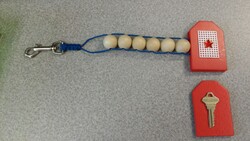Waiting Beads

** Before trying this strategy with your student with deafblindness, talk with your team to ensure it is an appropriate strategy **
For students with deafblindness, waiting can be very difficult because s/he may not be receiving enough information from the environment to know how long s/he will have to wait to do an activity. Waiting beads are one way of helping a learner understand that there will be an end to the waiting and how much longer s/he will have to wait. The effective use of waiting beads relies on consistency in their use and that the Intervenor is accurate in measuring the time increments represented by each bead.
Waiting beads help the learner with deafblindness to mark the passage of set increments of time. Each bead represents a predetermined amount of time. The increment of time depends on the learner's understanding of the concept. The time increment might be as short as 10 seconds or as long as 5 minutes. The Intervenor helps the learner move one bead at a time as the allotted amount of time passes. Then, the Intervenor shows the learner how many more beads there are to move before s/he will move onto the next activity.
When teaching the learner with deafblindness to use waiting beads, keep the time increments short. The Intervenor might start with 5 seconds or 10 seconds and practice moving through the beads. Do a motivating activity immediately following the waiting beads. As the learner begins to understand the concept of waiting, the time increments may be lengthened by a short amount at a time. Or, more beads may be added to the chain to represent a longer period of wait time.
Eventually, different sizes of beads or different textures may be used to indicate different increments of time. For example, small beads may indicate passage of time up to 5 minutes while larger the beads may indicate that there is a longer time increment between moving the beads. A learner with deafblindness may have a variety of waiting beads for different activities.
For this the strategy to be effective:
The Intervenor needs to be consistent and provide the accurate time increments to the learner with deafblindness. Simply handing the beads to the learner without going through the time increments will result in the beads becoming a toy. Additionally, it is not recommended to move one bead, leave to gather materials, return when it is convenient, and then move another bead.
Remember, the purpose of waiting beads is to teach the learner with deafblindness to anticipate the length of time required before doing an activity. Be consistent with time increments and you will help your student master the concept of time.
Kim, Micaela, and Julie created the Waiting Beads pictured on this page, when they worked with the Hudson School District Interdisciplinary Team in Wisconsin. The Waiting Beads were used with some of their students so that they learn the concept of waiting.
"What I love about these beads is that you can't lose any pieces! We needed a self-contained portable idea and this was perfect. [With] the waiting beads we attached the All Done symbol at the end to be consistent with the bus waiting beads." - Kim
